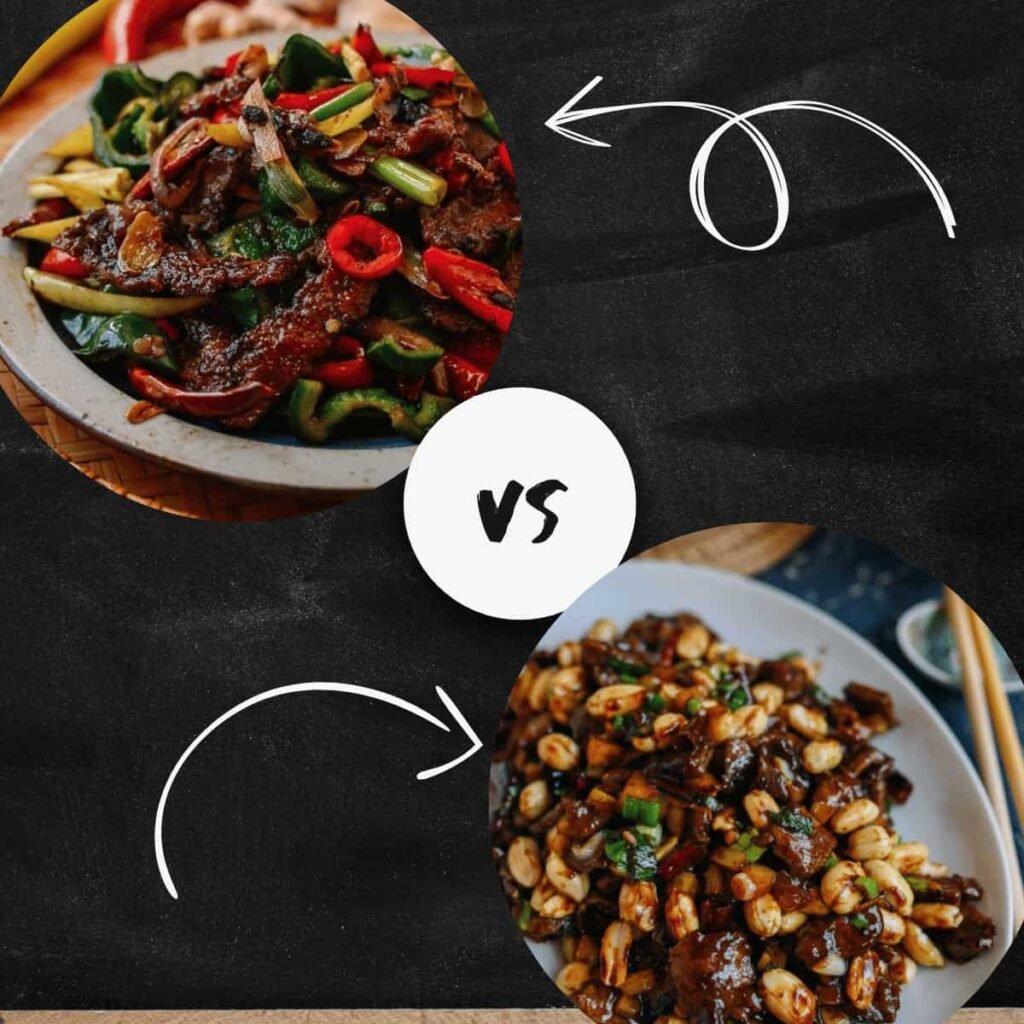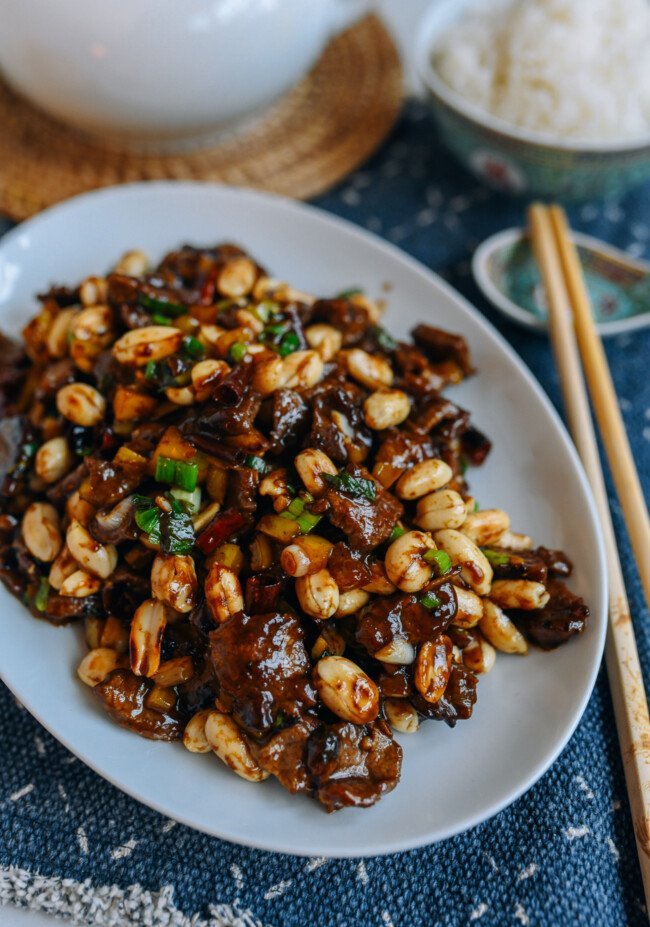Are you a fan of Chinese cuisine but find yourself confused when it comes to the differences between Hunan Beef and Kung Pao Beef?
You’re not alone.

Many people are unsure about the distinctions between these two popular dishes.
While they may share some similarities, they are also quite different in terms of flavor, ingredients, and preparation.
Hunan Beef and Kung Pao Beef are both spicy Chinese dishes that are well-loved by many food enthusiasts.
However, there are some key differences between the two that are worth exploring.
In this article, we will take a closer look at the origins of each dish, the ingredients used in their preparation, and the unique flavors that set them apart.
By the end of this article, you will have a better understanding of the differences between Hunan Beef and Kung Pao Beef and be able to make an informed decision next time you’re ordering Chinese takeout.
What is Hunan Beef?

If you’re a fan of Chinese cuisine, you’ve probably heard of Hunan beef before. But what exactly is it? Hunan beef is a popular dish that originated in the Hunan province of China. It’s a stir-fry dish that’s typically made with thinly sliced beef, vegetables, and a spicy and savory sauce. The dish is known for its bold and spicy flavors, which come from the use of ingredients like chili peppers, garlic, and ginger.
While Hunan beef is a popular dish in Chinese cuisine, it’s important to note that the version of Hunan beef that you might find at your local Chinese restaurant may not be entirely authentic. This is because many Chinese dishes have been adapted to suit the tastes of different regions and cultures. However, regardless of the version of Hunan beef that you try, you can expect it to be a flavorful and spicy dish that’s sure to satisfy your taste buds.
Some of the key ingredients that are typically used in Hunan beef include:
- Thinly sliced beef
- Chili peppers
- Garlic
- Ginger
- Scallions
- Soy sauce
- Vinegar
These ingredients are used to create a spicy and savory sauce that’s used to stir-fry the beef and vegetables. The dish is typically served with steamed rice, which helps to balance out the spiciness of the dish.
What is Kung Pao Beef?

Kung Pao beef is a spicy Sichuan dish that originated in China. It is made with tender beef, peanuts, vegetables, and spicy sauce. The dish is typically stir-fried and served hot. The sauce is made with soy sauce, rice vinegar, sugar, and chili paste. The heat level can vary depending on the amount of chili paste used.
Kung Pao beef is known for its unique combination of sweet, sour, and spicy flavors. The dish is often garnished with green onions and sesame seeds. The peanuts add a crunchy texture to the dish and help to balance out the spiciness of the sauce.
Kung Pao beef is a popular dish in Chinese restaurants around the world. It is often served with steamed rice or noodles. The dish can be customized to suit your taste preferences by adjusting the amount of spice or adding additional vegetables.
Similarities Between Hunan Beef and Kung Pao Beef
If you are a fan of Chinese cuisine, you may have tried both Hunan beef and Kung Pao beef. While these dishes have their unique characteristics, they also share some similarities that make them both delicious and popular.
Here are some of the similarities between Hunan beef and Kung Pao beef:
- Both dishes are spicy: Hunan beef and Kung Pao beef are known for their spiciness. They are made with chili peppers and other spices that give them their signature heat.
- Both dishes contain meat and vegetables: Hunan beef and Kung Pao beef are stir-fried dishes that typically contain beef and vegetables. The vegetables used may vary depending on the recipe, but both dishes often include bell peppers, onions, and scallions.
- Both dishes are served with rice: Like many Chinese dishes, Hunan beef and Kung Pao beef are often served with steamed rice. The rice helps to balance out the spiciness of the dishes and provides a nice contrast in texture.
While Hunan beef and Kung Pao beef have some similarities, they also have some distinct differences that set them apart from each other. Understanding these differences can help you choose the dish that best suits your taste buds.
Differences Between Hunan Beef and Kung Pao Beef
These two dishes are often compared due to their similar flavor profiles, but they are actually quite different. Here are some key differences between the two:
- Flavor: Hunan beef is typically made with a sweet and spicy sauce, while Kung Pao beef has a sweet, sour, and spicy sauce with a sprinkle of peanuts.
- Spiciness: Both dishes are spicy, but Hunan beef delivers a greater kick in terms of chili heat. Kung Pao beef is also spicy, but the heat is balanced out by the sweetness and sourness of the sauce.
- Texture: Szechuan beef is far juicier than Hunan beef since it is cooked with its marinade (or a homemade Szechuan sauce). On top of that, you have added juiciness from the tender meat and vegetables. Szechuan beef is also topped off with crunchy roasted peanuts for added texture. Hunan beef is generally less moist.
- Ingredients: Hunan beef usually includes vegetables such as broccoli, carrots, and peppers, while Kung Pao beef typically includes green onions and red peppers. Kung Pao beef also includes peanuts, which are not typically found in Hunan beef.
- Serving: Hunan beef is usually served as part of a multi-course meal or stir-fried plate with veggies or side dishes, whereas Kung Pao typically stands alone.
Overall, both Hunan beef and Kung Pao beef are delicious dishes that are worth trying if you haven’t already. While they share some similarities, they have distinct differences that make them unique. Whether you prefer sweet and spicy or sweet, sour, and spicy, both dishes are sure to satisfy your taste buds.
Tips on How to Choose Between Hunan Beef and Kung Pao Beef
Choosing between Hunan Beef and Kung Pao Beef can be a tough decision, especially if you are not familiar with the differences between the two dishes. Here are some tips to help you make the right choice:
- Spiciness: If you love spicy food, then Kung Pao Beef is the way to go. It is known for its spicy and tangy flavor, thanks to the use of Sichuan peppercorns and dried red chili peppers. On the other hand, if you prefer a milder level of spiciness, then Hunan Beef is a better option. It is still spicy, but not as much as Kung Pao Beef.
- Sweetness: Kung Pao Beef is usually sweetened with sugar or honey, which helps to balance the spiciness. If you have a sweet tooth, then this dish is for you. Hunan Beef, on the other hand, is not sweetened and is known for its bold and savory flavors.
- Ingredients: Kung Pao Beef typically includes peanuts, scallions, and red bell peppers, while Hunan Beef often contains a variety of vegetables such as broccoli, carrots, and green beans. If you are a fan of peanuts, then Kung Pao Beef is a must-try.
- Preparation: Kung Pao Beef is stir-fried with a spicy sauce, while Hunan Beef is often braised or stewed in a savory sauce. If you prefer your meat to be more tender, then Hunan Beef is the way to go.
- Origin: Kung Pao Beef originated in the Sichuan province of China, while Hunan Beef comes from the Hunan province. If you want to try a dish that is more authentic to a specific region, then this may be a factor to consider.
Ultimately, the choice between Hunan Beef and Kung Pao Beef comes down to personal preference. Both dishes are delicious and offer unique flavors and textures. Whether you prefer spicy and sweet or bold and savory, you can’t go wrong with either option.
Hunan Beef vs Kung Pao Beef: FAQs
Here are some common questions about Hunan Beef and Kung Pao Beef:
What is the origin of Hunan Beef and Kung Pao Beef?
Hunan Beef is a dish from the Hunan province of China, while Kung Pao Beef originated in the Sichuan province of China.
What are the main differences between Hunan Beef and Kung Pao Beef?
Hunan Beef is typically spicier than Kung Pao Beef and has a drier taste that allows the heat of the spicy ingredients used to be more evident and impactful. Kung Pao Beef, on the other hand, is based on a Sichuan dish and so that kind of spice is more numbing, not letting you taste the full scale of the dish’s heat. Kung Pao Beef also has a sweet and sour flavor due to the use of vinegar and sugar in the sauce, while Hunan Beef has a more savory and salty flavor.
What are the key ingredients in Hunan Beef and Kung Pao Beef?
Hunan Beef typically uses sliced beef, garlic, ginger, soy sauce, chili peppers, and vegetables such as bell peppers and onions. Kung Pao Beef typically uses diced beef, garlic, ginger, soy sauce, vinegar, sugar, Sichuan peppercorns, and vegetables such as bell peppers and zucchini. Kung Pao Beef also often includes peanuts or cashews for added crunch.
Which dish is healthier, Hunan Beef or Kung Pao Beef?
Both dishes can be made healthier by using lean cuts of beef and reducing the amount of oil in the cooking process. However, Kung Pao Beef tends to have more sugar and calories due to the sweet and sour sauce, while Hunan Beef is typically lower in calories and sugar but higher in sodium due to the use of soy sauce.
Which dish is better for someone who loves spicy food?
For someone who loves spicy food, Hunan Beef is typically the better choice as it is known for its intense heat and use of chili peppers. Kung Pao Beef is also spicy, but the numbing effect of the Sichuan peppercorns can make it less satisfying for those who love a true spicy kick.
Jenny has always been passionate about cooking, and she uses her platform to share her joy of food with others. Her recipes are easy to follow, and she loves giving tips and tricks to help others create their own unique culinary creations.

